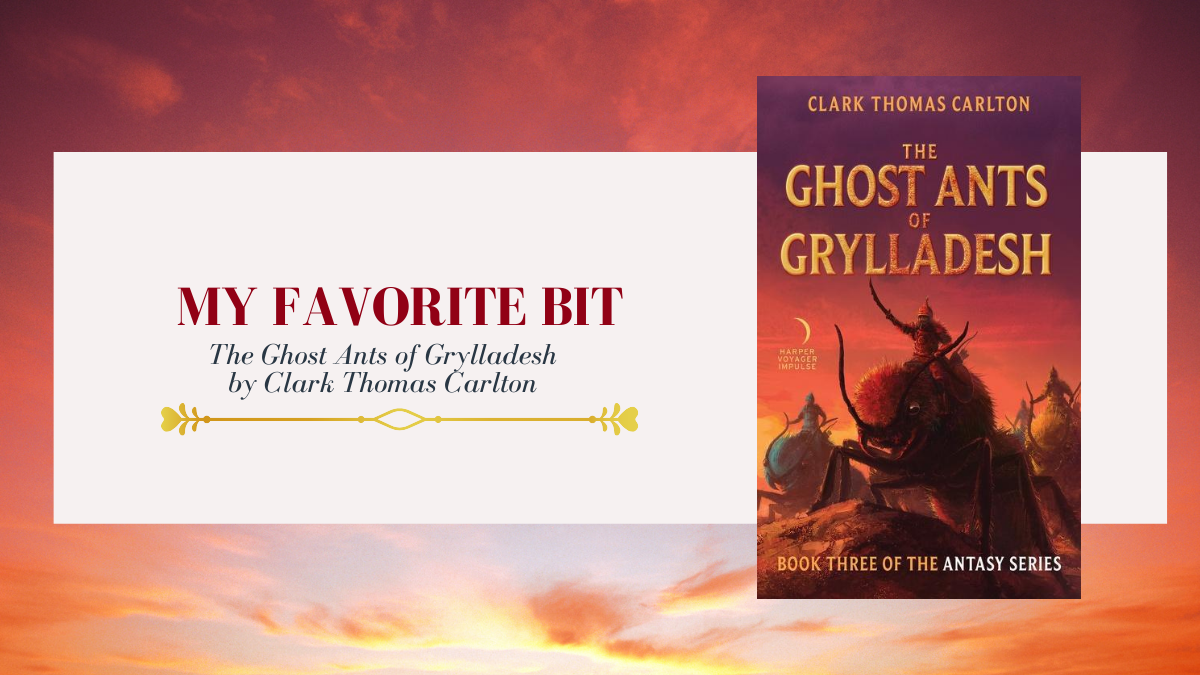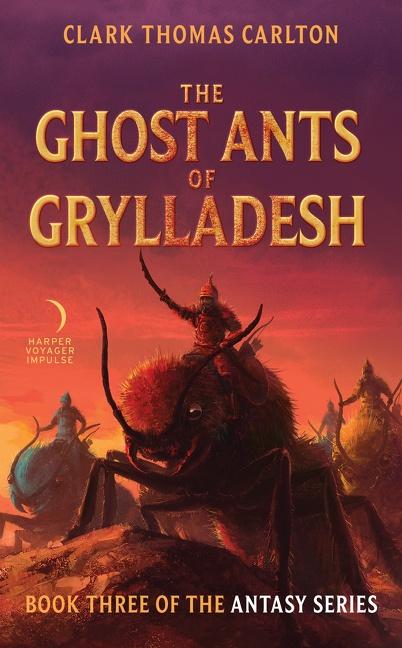
Clark Thomas Carlton is joining us today to talk about his novel, The Ghost Ants of Grylladesh. Here’s the publisher’s description:
Nothing compares to the Antasy Saga, a highly original series set in a distant future where humans have evolved to the size of insects and intertwined with their world. Book One, Prophets of the Ghost Ants, was named a Best of the Year by Kirkus Reviews and was followed by Prophet of the Termite God.
The final chapter of the trilogy, The Ghost Ants of Grylladesh, continues the story of an empire in ruins, vicious and mysterious usurpers, and a young man who would lead his people from hopeless squalor to a stable utopia.
In the Barley Lands to the East, the deformed and demented Emperor Volokop has blinded the hero Anand and sent him to Dranveria with a message for its rulers. But when Anand is captured by a mysterious people, the fate of his family and his new nation of Bee-Jor is suddenly in jeopardy.
Because Bee-Jor remains in chaos. In the South, starving refugees from Hulkren have overwhelmed Mound Palzhad and segregated into warring camps to fight for their very survival … with some descending into cannibalism. Beyond them, the roach riders of The Promised Clearing threaten a new conflict in a quest for more land. And in the West, a new peril arises from the Velvet Ant League, one not seen in a thousand generations.
Aiding all of these enemies is the deluded Queen Trellana, who has gathered the royal women of the East to march out of Bee-Jor and leave it vulnerable to attack.
The founding of Bee-Jor was Anand’s dream of a perfect society, but without their leader, is that all it ever will be: a dream?
What’s Clark’s favorite bit?

CLARK THOMAS CARLTON
As a kid, I spent hours observing different kinds of ants on a sand lot in back of our house. I was fascinated when some red ants and black ants established their colonies too close to each other. They were soon at war, snipping off each others’ heads and legs until there were thousands of casualties splayed on the sand. A truce and then a treaty between them did not seem to be an option.
Years later as an adult, I was visiting the Yucatan when a Spanish peanut rolled under my chaise lounge at a Club Med. Within minutes, it was covered by two different tribes of ants who could not each take a half and then peacefully part. Instead, the ants were irresistibly drawn to destroying each other and the peanut was neglected.
The following morning I woke from a dream where I was one of thousands of tiny soldiers riding on the backs of black ants. I was leading this army into battle against some soldiers on their red ants and was filled with a boiling hatred for a faceless enemy. I sensed all this was connected to reading I’d done on evolutionary biology and in particular, the immutability of human and ant behavior when it came to war and the territorial imperative. I knew this dream was the seed of a science-fantasy series.
The fantasy part of the Antasy trilogy was imagining men and women evolving to the size of insects and retaining their intelligence as well as the general physiognomy of humans. The science part was finding a way that these tiny people could parasitize ants in a credible way. In movies like Honey, I Shrunk the Kids and novels like Atta, the ants are creatures with mammalian characteristics. They have a capacity for language and warm friendships and behave more like dogs or ponies or fairy godmothers than insects. Real ants, depending on their kind, would either flee from little humans or gather to attack them if they sensed an invasion. Some ants would react to a tiny man or woman as prey to be stung to death, sliced into pieces and then shared with her colony as a nourishing pulp.
Just how could my humans live among ants without triggering the flight, fight or eat response?
My favorite bit, the solution to this problem, came as a result of the reading I did on ants. That began with the master tome The Ants by Edward O. Wilson, the Second Darwin, and the esteemed myrmecologist, Bert Holldobler. I learned that ants have a number of parasitic and parasitoid insects who infiltrate their colonies. These include silk moths and their “worms” (larvae) as well as some outsized beetles which bear no resemblance to ants except in one way: they smell like them. Parasitic insects like nest beetles can live among ants because the beetles exude the same pheromones as their hosts. An ant approaching one of these parasites would touch/smell the beetle with her antennae and accept it as one of her thousands of sisters just before the beetle chewed her head off for lunch.
The parasitic humans of Antasy do something similar in order to live among various ants: the humans are thieves of the ants’ colony odor and infuse it in their clothing and coat their skin with it. Ant peoples wear pairs of false antennae on their heads to negotiate passage with their hosts who are always sniffing/touching each other to confirm kinship. This scent disguise allows the humans to exploit the ants as their main source of food and to use them as beasts of burden, transportation and as war machines.
And what would be the punishment for a member of this human society who violated its laws, especially those that flouted caste restrictions? These criminals are punished with ‘death by bathing.’ In a public spectacle, the guilty would be stripped of kin-scent — the colony odor — which would trigger their immediate and bloody destruction by ants. My protagonist, Anand the Roach Boy, is a half-breed with ties to a different culture and he wants to end this practice and other cruel and unusual punishments.
LINKS:
The Ghost Ants of Grylladesh Book Link
BIO:
Clark Thomas Carlton’s first novel of the Antasy series, Prophets of the Ghost Ants, was named a Best of the Year by Kirkus Reviews. He completed Book 2 of the Antasy series, The Prophet of the Termite God in 2019 and the third in the series, The Ghost Ants of Grylladesh will be released at the end of June in 2021. He is an award winning playwright as well as a journalist, television writer and a producer of so-called reality television. Clark was hired to work on at least 20 different screenplays, only a few of which ever made it to the screen and none of which he hopes anyone ever sees. Between writing projects he paints psychedelic landscapes and is known as “Grandma Moses on acid.” He divides his time between Hollywood and Palm Springs and hopes to resurrect an Eighties inspired synth pop opera set in ancient Babylon about the building of the Hanging Gardens.
